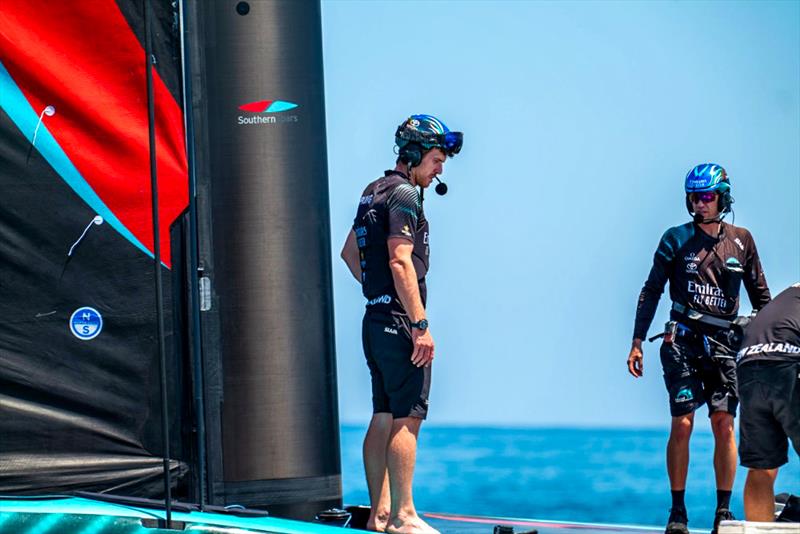
Inside the America's Cup: A closer look at AC75 masts and rigging
by Kate Davison 6 Sep 2024 14:47 UTC
7 September 2024

Southern Spars won their first America's Cup in 1995 with Team NZ in San Diego © Emirates Team New Zealand
As the Round Robins progress and Barcelona delivers, the AC75 fleet is looking fast.
Whether it’s the return of the cyclors, enhanced foil designs, aero improvements, or more advanced control systems, a range of technical innovations are frequently cited as the reason for driving this impressive performance. In this respect, one area that may have received less attention is the rig and rigging design. Yet, especially since the arrival of composite materials in the America’s Cup, it’s an area that has had a formative impact on how things play out on the water.
Southern Spars has played a leading role since entering the America’s Cup fold in 1995, with the supply of Team New Zealand’s innovative high-performance carbon mast that took them to a historic victory. Southern Spars’ sister company, Future Fibres, is also increasingly central to the trajectory of composite innovation in the Cup.
Class Rules
AC75 class rules specify several key one design aspects of mast design and construction. They stipulate the shape (D-section) and the size (within a tolerance) of the mast tube. The Rule also dictates the required carbon fibre specification, including the fibre modulus, areal weight, and resin content. Additionally, the geometry and materials of the fittings, such as shrouds and spreaders, mast rotation restriction to 45°, and the height of the mast rotation ball relative to the waterline are all defined by the rule.
Mast Rotation
Through controlling the 45° mast rotation, each team has at their disposal a mechanism to access enhanced power and performance. All AC37 participants have selected North Sails as their best option such is the compelling performance of the North Sails Helix structured luff technology, which has redefined what a sail can deliver—its internal structure enhancing power potential by controlling the loads through the sail structure, delivering a proactive, positive sail shape.
With a mast designed to react to the conditions by rotating to the exact degree needed to exploit every breath of wind and realise the sail shape intended by the team’s sail designers, the benefits of Helix are taken to the extreme. You could almost say that the masts on AC75s have become part of the sail, or the other way around, and it definitely feels like the lines are blurring between the essential elements of the engine above deck.
Thickness & Stiffness
Another way masts influence sail shape is, of course, mast bend. This is the stand-out area where teams can differentiate their masts to influence performance. While the D-spar minimum laminate and core details are specified under AC37 class rules, teams are free to add more laminate if they choose to. There are always weight to performance trade-offs, but there is scope within the teams to increase the overall stiffness of the mast, or to alter the deflection response—optimising it to suit the desired degree of mast bend that the team’s sail designers are calling for.
No Backstay
While the rigging for AC37 is a fully one design “supplied” component from by Future Fibres, identical onboard each AC75, some significant changes have been made to the rigging packages since the 36th America’s Cup. One talking point is the elimination of the backstay, which also has a knock-on effect on the wider engine above deck. Mast bend, which would conventionally be influenced by backstay control, is now almost solely manged by sail controls. Another knock-on effect is escalating load through the shrouds, which has required the cap shrouds to be enlarged and jib locks to be upgraded from 5t to 8t for this edition of the cup. One constant though, and as per the AC36 rule, the Future Fibres rigging packages are equipped with integrated fibre optic load monitoring, for performance analysis and to keep an eye on loading limits.
Looking Ahead
Beyond the talking points we have summarised here – luff tracks, batten stiffness, batten locations, halyard locks and mainsail controls – all sit within the remit of team designers. It remains to be seen which technical factors will rise to the surface during the 37th America’s Cup, but it is a safe bet that ripple effects from technological choices and innovations will be felt around the wider sailing landscape in the coming years.
General Manager of Southern Spars, Mark Hauser comments, “we are immensely proud of our close partnerships with the teams and together we commit ourselves entirely to the pursuit of excellence. Innovation in the Cup reverberates around the industry for years thereafter and we are proud to be leading the charge with the world’s most elite sailing teams.”